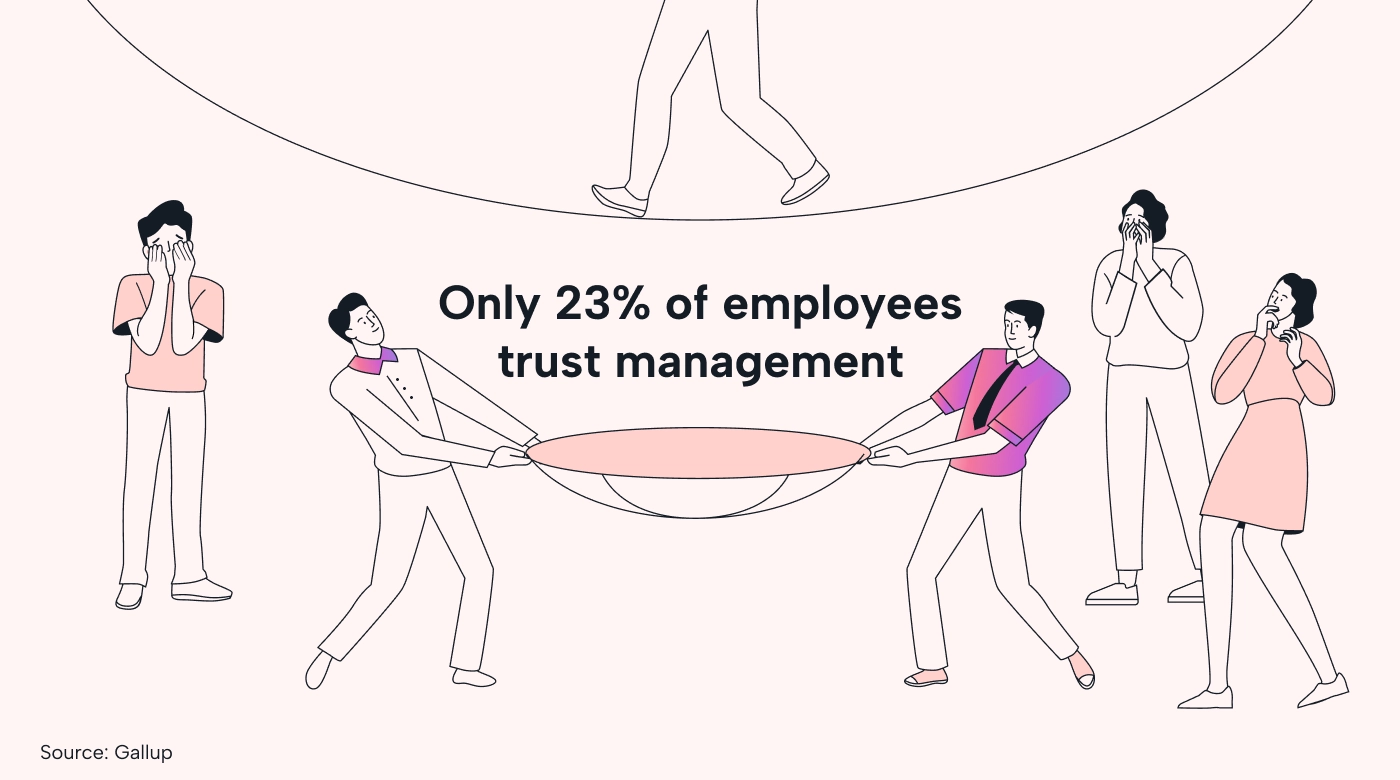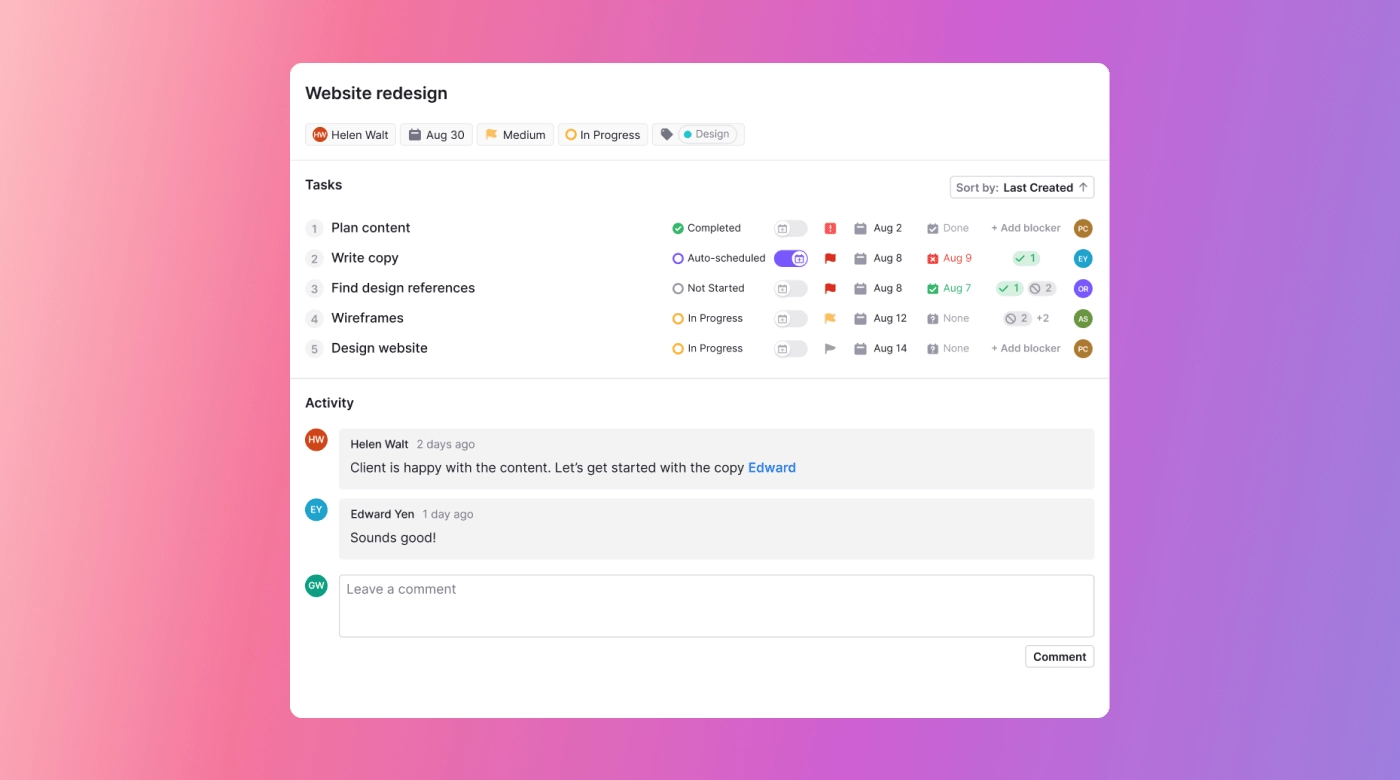Low morale at work can sneak up on you.
Maybe it starts with an employee no longer contributing during meetings. Then, they stop showing up at all. Or perhaps a few negative comments turn into a full-blown pessimistic attitude toward seemingly everything.
If you suspect a decrease in employee morale, rest assured that we’re here to help.
This article examines low morale in the workplace, including its common signs and causes. It also lists actionable ways you can start increasing morale (and your bottom line) today.
What is low morale at work?
Morale refers to the confidence, enthusiasm, and energy a person brings to the job or task at hand.
 |
When morale is high, employees demonstrate positive, focused energy and excitement in the workplace. They also develop strong connections and strive to collaborate well as they work together toward common goals.
Morale may ebb and flow slightly with home and life demands. However, persistent low morale at work is difficult to hide.
Watch for these red flags of diminished morale in the workplace:
- Employees’ productivity level decreases. Missed deadlines, a decline in work quality, and careless mistakes may occur more often than they did before.
- Employees stop taking initiative with new roles, responsibilities, or projects. It may also be difficult to find a team member who wants to step up to the plate for these things.
- Employees demonstrate pervasive negative attitudes and behaviors. They may complain, gossip, blame, or refuse to take responsibility for their actions.
- Absenteeism and tardiness increase. Employees may also stop showing up to meetings or other critical check-ins.
- Employee turnover increases. They may want to leave a frustrating situation to find new opportunities.
- Successful communication and collaboration are rare. Employees may not trust each other or be motivated to work together.
Now that you know the signs of low morale, let’s turn to the causes.
What causes low morale in the workplace?
Several factors come into play when it comes to drops in employee morale, including the following:
- Sudden or unforeseen changes in the workplace. These could include new organizational structures, management, or team members. Morale may also be affected if expected policies, procedures, or job roles change.
- Employees with heavy workloads. This is especially true if they feel as though they simply can’t catch up or reach success in their projects.
- Micromanagement. Employees who don’t feel trusted to do their jobs can become resentful and frustrated.
 |
This is an even bigger challenge since only about one in four employees trust management to have their backs in challenging situations.
- A lack of team cohesion. When team members don’t work as a high-functioning team, their perception of their work can become negative.
- A persistent lack of recognition for their work, efforts, and accomplishments. These issues lead to discouragement and disengagement over time. Only 23% of employees feel they receive the right amount of recognition in the workplace.
- A toxic culture. This problem prevents employees from putting forth their best effort and enthusiasm in their work. They may also feel uncomfortable or unsafe in speaking out. If team members are prone to gossip or gaslighting, they might even stop attending meetings or showing up to work altogether.
- Various outside factors. Employees may struggle in their personal lives or be at the mercy of unforeseen community, national, or global events.
While there are a number of factors that can lead to low morale at work, many of them are within your control. Let’s get into how you can take action.
12 effective ways to address low employee morale
If you’re ready to tackle low morale at work, here are some of the best ways to get started:
1. Revisit your onboarding process
Did you know that a high-quality onboarding process improves productivity, builds loyalty, and fosters engagement right from the start?
Start by streamlining the paperwork involved so that employees can efficiently access and quickly complete tedious forms during their downtime.
Involve team members in the introductory and training processes, too, so that they start feeling engaged and like part of the team right away. Assign a mentor or support colleague for each new employee to call upon when needed.
Roll out the workload gradually so your new team member feels successful early.
Set a weekly recurring task in Motion to check in frequently with new employees, listen to their concerns, and take care of any issues they may be facing.
2. Demonstrate inclusive practices
Employees who believe their workplace focuses on inclusion and diversity demonstrate higher engagement and better job performance as a result.
 |
Incorporate the element of inclusion in your company’s mission, values, and goals.
Provide professional development opportunities for employees to learn more about cultural and generational differences and how they may affect workplace communication styles, attitudes, and preferences.
Empower your employees to identify biases and learn how to address them appropriately through workshops and team-based training.
Ensure company tech and workspaces are accessible for employees of all abilities. For example, shared office spaces should have wide doorways, elevators, and ramps to accommodate wheelchair users.
3. Transform your meetings
Ineffective, frequent, and lengthy meetings drain employee morale over time.
Look at your current meeting schedule and whittle it down to the mission-critical. Schedule meetings only when necessary, and eliminate any that only add unnecessary clutter to your calendar.
Follow best practices and virtual meeting etiquette to include and support members of your remote or hybrid workforce.
Send out meeting agendas to attendees beforehand and stick to them once the meeting has begun.
Identify and establish participant roles, such as timekeeper, notetaker, and facilitator, to keep meetings organized and on track. Also, follow up in writing on any action items or deadlines discussed.
Check in with team members about preferred no-meeting days or times and block them off in the calendar.
4. Set clear goals
Clear goal-setting ensures every team member is on the same page regarding objectives and timelines.
Get in the habit of establishing strategic, measurable, achievable, relevant, and time-bound (SMART) goals. If your goals don’t include each of these components, go back to the drawing board.
Show your employees how your team’s goals and objectives relate to the larger company mission to demonstrate the importance of their contributions.
Encourage effective collaboration across channels, including chat spaces, email, and video conferencing, so your team can stay informed.
Turn to the Motion Project Manager to support team collaboration.
 |
This feature measures how much each employee can accomplish, adds work to each of their schedules, and allows them to chat about ongoing projects.
5. Build up your teams
Establishing strong teams goes beyond goal-setting. Ensure each team member understands their role and how they contribute to the big picture.
Proactively address concerns at the outset and address any necessary gaps.
Also, engage in a variety of team-building activities to encourage team relationships to form and foster collaboration. For example, ask each member to complete a quick personality test so they can learn more about each other. You can also host a virtual coffee chat or happy hour to include remote or hybrid workers. Or find out your employees’ interests, and then meet monthly for a group hike, bowling night, or cooking class.
6. Provide training and development opportunities
Forty-two percent of employees feel their employer offers them valuable professional development, and 48% of workers in the United States would change jobs if another employer offered upskill training.
Who in your employ could benefit from a mentorship? Who stands out as a possible upskilling candidate? Who could be given more job responsibilities? Who might be ready for a promotion or another career advancement?
Work with HR to provide employees with professional development opportunities through easily accessible webinars, courses, or professional certifications.
7. Recognize success
Don’t let your company be one of the many that fail to recognize their employees. Establish robust and consistent employee recognition programs company-wide.
 |
Recognize Individual and group accomplishments, both privately and publicly. And be specific. Avoid the generic “great job” and zero in on exactly what they did and why it matters.
Here are some ways you can acknowledge your employees for a job well done:
- Send a handwritten thank-you note or personalized email.
- Post standout achievements in shared chat spaces or establish a “kudos” thread so others can do the same.
- Recognize employee contributions before you kick off your regular meetings.
- Celebrate your team’s accomplishments with a catered lunch or treat them to happy hour at a local pub after hours.
- Consider offering monetary rewards, such as bonuses, promotions, incentives, stock options, or gift cards.
8. Monitor workloads regularly
While employees may be able to handle heavy workloads most of the time, be sure to check in with them anyway.
Get regular feedback about their current workloads and whether they need support or adjustments to succeed.
The Impact of heavy workloads doesn’t have to be negative, especially if employees feel a sense of satisfaction and appreciation for their time, energy, and effort.
Get on top of your employees’ workloads with Motion. You can view every team member’s week at a glance to ensure equitable workloads and more successful outcomes.
9. Investigate flexible schedules
Did you know that 87% of employees would choose flexible work if given the opportunity?
Flexible schedules allow for a better work-life balance. Your company may already offer remote or hybrid options, but could some employees benefit from an adjusted workday, too?
For example, some employees may want to beat traffic by having an earlier start and end time. Others may want to work longer days on Mondays and shorter days on Tuesdays so that they can get their kids to their extracurriculars on time.
Look into departmental and company-wide options, too, when it comes to scheduling.
10. Offer sufficient support
Employees who feel supported in their endeavors show improved morale and engagement, which leads to better productivity and performance.
Ensure your team has enough support to complete their tasks. They should also know who to contact when they need help.
Place written policies and procedures in shared spaces for easy reference.
Establishing clear goals also makes it easier for your team to understand and act on their priorities.
Motion’s Task Manager takes the pressure off everyday scheduling.
 |
Simply input your task priorities to achieve a personalized schedule. Motion even helps to keep you on track (and avoid those ever-present distractions) with a customizable banner.
11. Prioritize employee well-being
Support a positive work-life balance to communicate the importance of individual well-being to the company.
Encourage employees to set clear boundaries around their home and work lives; this is especially important for your remote and hybrid workforce.
Mandate scheduled lunches and breaks in employees’ weekly calendars and ensure they take them. Even a few minutes away from their desk to take a brisk walk or brew a cup of tea is enough for them to feel restored and recharged for the rest of the day.
12. Elicit feedback
Whether you suspect morale is low at work or you’re on the road to improving it, plan to obtain employee feedback regularly. Review your efforts to raise morale and make any needed adjustments.
You can also check in with your employees one-on-one to see how they’re feeling. With the Motion Meeting Assistant, you can scan their availability instantly and schedule a meeting based on when they’re all able to attend.
And don’t forget to use anonymous methods, such as pulse surveys or a suggestion box, to hear ideas your employees might otherwise keep quiet.
Review and address any clear issues with managers, especially if you’ve found out micromanagement has been an issue for employees.
Bolster employee morale with Motion
Overcoming low morale at work takes time and effort. So, why not make the path forward smoother with Motion?
Motion helps team members stay in touch through one easy-to-use platform. Employees can check their projects at a glance and immediately get any questions or concerns resolved, improving their overall satisfaction.
Get started with a free 7-day trial today, and watch your team’s morale soar.

Jodi Monroe is a content writer and blogger in the SaaS space. When not at her laptop, she’s planning her next travel adventure.




